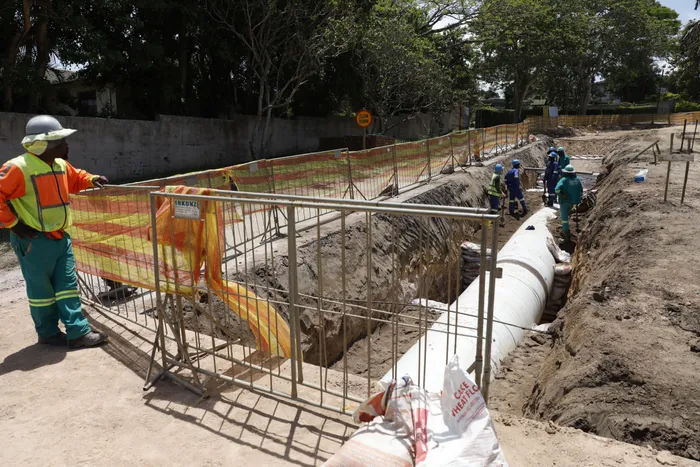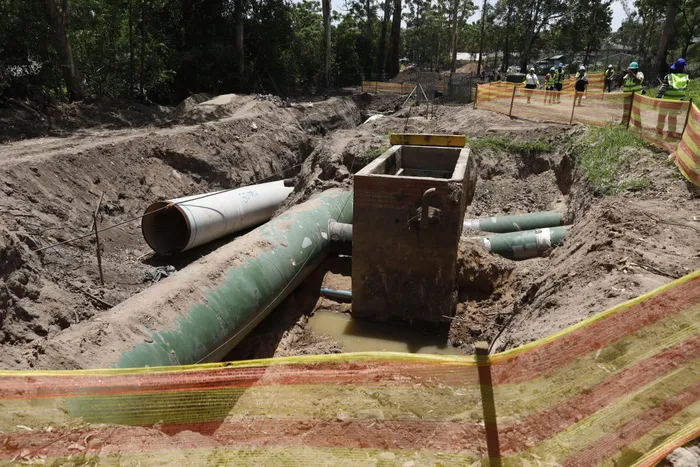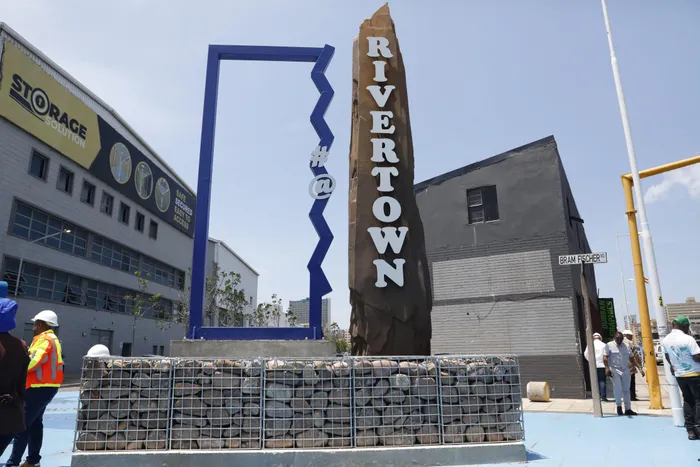Enhancing water delivery in eThekwini: A closer look at the Southern Aqueduct

A view of the ongoing construction at the Southern Aqueduct, which is set to alleviate water shortages in areas like Isipingo and uMlazi.
Image: Doctor Ngcobo / Independent Newspapers
During a Durban inspection of service delivery projects on Thursday, a visit to the Southern Aqueduct raised questions about water provision to residents.
A delegation led by co-chairs of the Presidential eThekwini Working Group (PeWG), Phindile Baleni (director-general in the Presidency) and Mike Mabuyakhulu, inspected major service delivery projects. This included a visit to the Moses Mabhida Stadium, Rivertown Precinct, Southern Aqueduct, uMlazi Canal, and Phoenix Industrial Park.
Executive director in the City Manager’s office, Sipho Cele, expressed confidence that the city is making progress and is closer to effectively delivering services to residents.
However, he noted that the PeWG cannot simultaneously cover the entire eThekwini area.
He added that the PeWG aims to increase city efficiency, and the support received has enabled them to rework their systems.
The Southern Aqueduct will boost bulk water security and resilience in the southern region. Divided into eight packages, construction is 40% complete, with full commissioning expected by mid-2026.

Officials inspect the Southern Aqueduct project, a key initiative aimed at improving water delivery in Durban’s southern regions.
Image: Doctor Ngcobo / Independent Newspapers
The inspection showcased progress in tourism revitalisation and vital improvements in water and environmental infrastructure.
The PeWG was formed after President Cyril Ramaphosa and the Durban Chamber of Commerce and Industry (DCCI) discussed and decided to address water supply issues, ageing infrastructure, declining tourism, crime, and port inefficiencies.
“We have what we’re calling the Northern Aqueduct project, which was to improve water delivery to the northern areas. We previously had problems or challenges of water in Ntuzuma, Inanda, but with the completion of that project, we’re actually having less outages and water shortages in the Inanda, Ntuzuma, Verulam, and Phoenix areas as well. So, that’s the first delivery that we will be able to talk about, which has improved water delivery,” Cele said.
“One of the projects that we are going to be visiting today (Thursday) is the Southern Aqueduct, which is a project that’s under way that’s aimed at improving water delivery in the southern areas of Isipingo, uMlazi, KwaMakhutha, Folweni, and such places. Of course, that project is not yet over, but it’s actually at an advanced stage and we hope that in the next six to 12 months, it will come on stream and it will actually alleviate the water crisis in the southern areas.”
Cele said visible progress is evident in some areas. Where it is not, concrete projects are actively being implemented on the ground. These initiatives are designed to secure a better, and hopefully near, future.

PeWG co-chair Mike Mabuyakhulu highlighted the commitment to addressing water supply challenges during the inspection of Durban’s infrastructure projects.
Image: Doctor Ngcobo / Independent Newspapers
PeWG co-chair Mabuyakhulu said the presidential working group has several work streams, which are doing an exceptional job.
He said workstream two deals with water and sanitation.
“We are talking about the provision of water, not necessarily to a certain sector of society, but to the whole citizenship of eThekwini. So we are, therefore, focusing on some of these activities for the people of eThekwini as a whole,” Mabuyakhulu said about communities that might feel neglected over service delivery.
He said their focus is not solely on the interests of one specific group, but on the collective interests of the people of eThekwini.

The Presidential eThekwini Working Group visited the Rivertown Precinct.
Image: Doctor Ngcobo / Independent Newspapers
Speaking about the Rivertown Precinct, Mabuyakhulu said the decay often found in the older sections of any city globally necessitates an inner city rejuvenation strategy. This strategy is crucial for addressing the historical core of the city as it expands outwards, ensuring a deliberate plan for renewal. The precinct is a direct reflection of this commitment to rejuvenating the city’s older parts.
He said the city’s aged infrastructure, originally designed to serve a small population, is struggling to cope with the increased demand resulting from rapid growth and wider availability, causing current issues.
Co-chair Baleni said: “Witnessing how eThekwini has implemented initiatives to address service delivery challenges while boosting business confidence is commendable.”
DCCI vice-president Kim MacIlwaine said: “What I found from today’s presentation was how much progress has been made that probably hasn’t been communicated widely enough within the city to its residents, to its businesses,” MacIlwaine said.
He said there is commitment from the Presidency, the director-general, downwards, to address the remaining issues, which are complex.
“I think the big issue that’s outstanding is water and sanitation. I think the underlying issue is the fact that there’s been many years of insufficient maintenance… really practical issues, ageing pipes, etc,” MacIlwaine said.
thobeka.ngema@inl.co.za